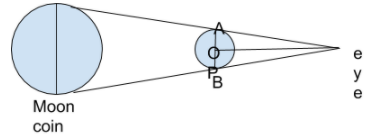
If the angular diameter of the moon is
Answer
507k+ views
Hint: The concepts of general trigonometry will be used in this question. The observer’s eye and the diameter of the coin form an isosceles triangle with the diameter of the coin as the base. We know the angle subtended by the coin on the eye, so will can find the distance between the coin and the eye using general trigonometric formulas. Some formulas to be used are-
Complete step-by-step answer:
First, we will construct a diagram such that the coin just about covers the moon behind itself, as shown. This diagram is not to scale as the moon is much larger away from the earth than the moon.

The diameter of the coin AB is 2.2 cm. Also, we know that the angular diameter of the moon is
Similarly, the line PO divides the opposite side AB in two equal halves at O.
We have to find the distance of the coin from the eye, which is the length of the line PO. For this, we will consider the right-angled triangles AOP and BOP. We can write that-
Hence, the distance from the eye a coin of diameter 2.2 cm can be kept to hide the moon is about 4.10 cm
Note: The most common mistake here is that students use the formula
Complete step-by-step answer:
First, we will construct a diagram such that the coin just about covers the moon behind itself, as shown. This diagram is not to scale as the moon is much larger away from the earth than the moon.

The diameter of the coin AB is 2.2 cm. Also, we know that the angular diameter of the moon is
Similarly, the line PO divides the opposite side AB in two equal halves at O.
We have to find the distance of the coin from the eye, which is the length of the line PO. For this, we will consider the right-angled triangles AOP and BOP. We can write that-
Hence, the distance from the eye a coin of diameter 2.2 cm can be kept to hide the moon is about 4.10 cm
Note: The most common mistake here is that students use the formula
Recently Updated Pages
Master Class 11 Economics: Engaging Questions & Answers for Success

Master Class 11 Business Studies: Engaging Questions & Answers for Success

Master Class 11 Accountancy: Engaging Questions & Answers for Success

Master Class 11 English: Engaging Questions & Answers for Success

Master Class 11 Computer Science: Engaging Questions & Answers for Success

Master Class 11 Maths: Engaging Questions & Answers for Success

Trending doubts
State and prove Bernoullis theorem class 11 physics CBSE

1 ton equals to A 100 kg B 1000 kg C 10 kg D 10000 class 11 physics CBSE

State the laws of reflection of light

One Metric ton is equal to kg A 10000 B 1000 C 100 class 11 physics CBSE

1 Quintal is equal to a 110 kg b 10 kg c 100kg d 1000 class 11 physics CBSE

Difference Between Prokaryotic Cells and Eukaryotic Cells




